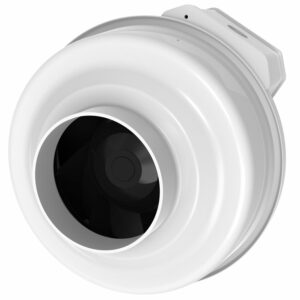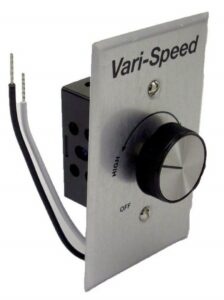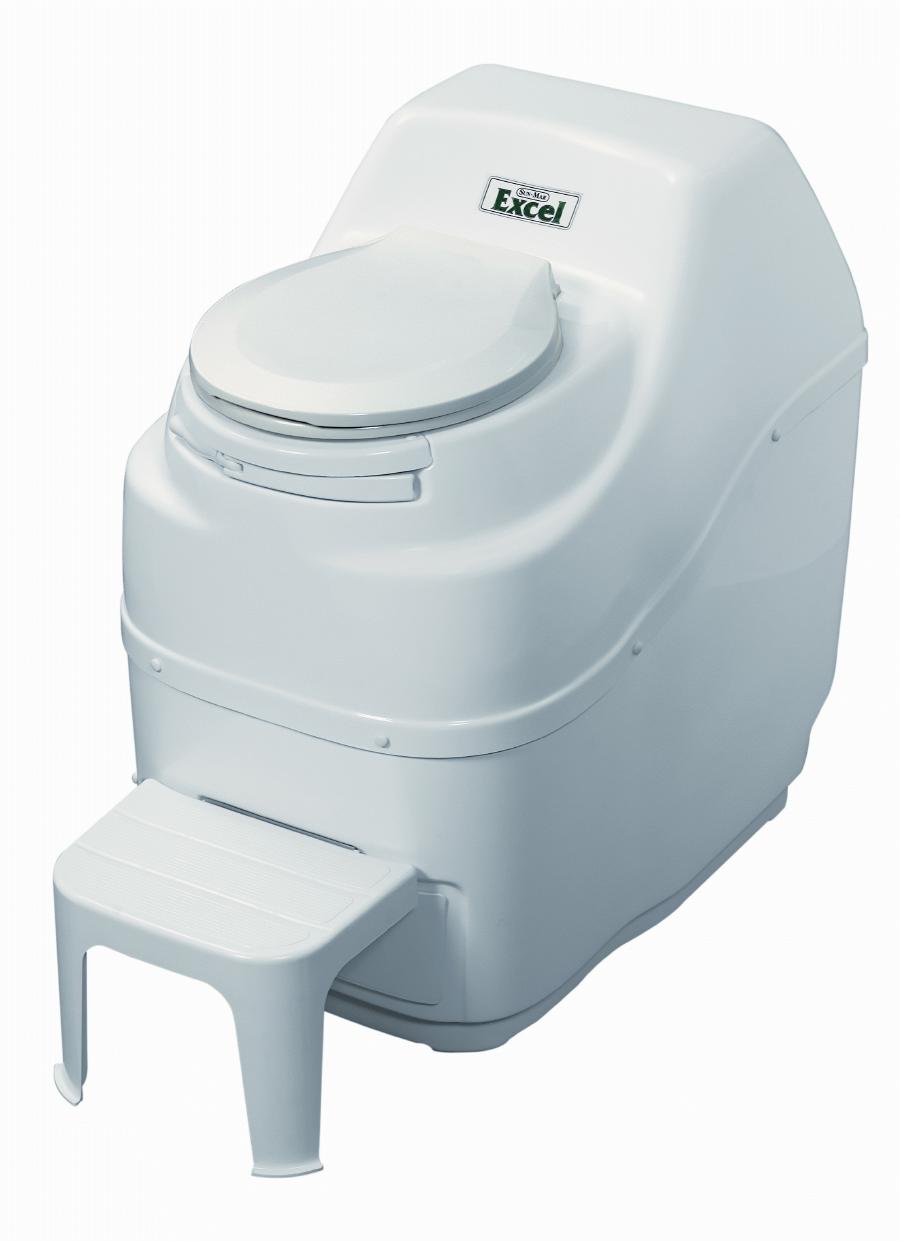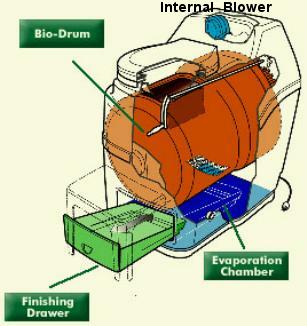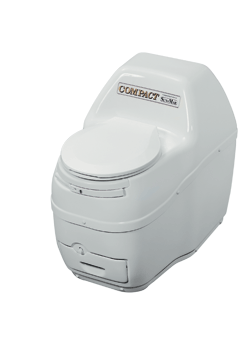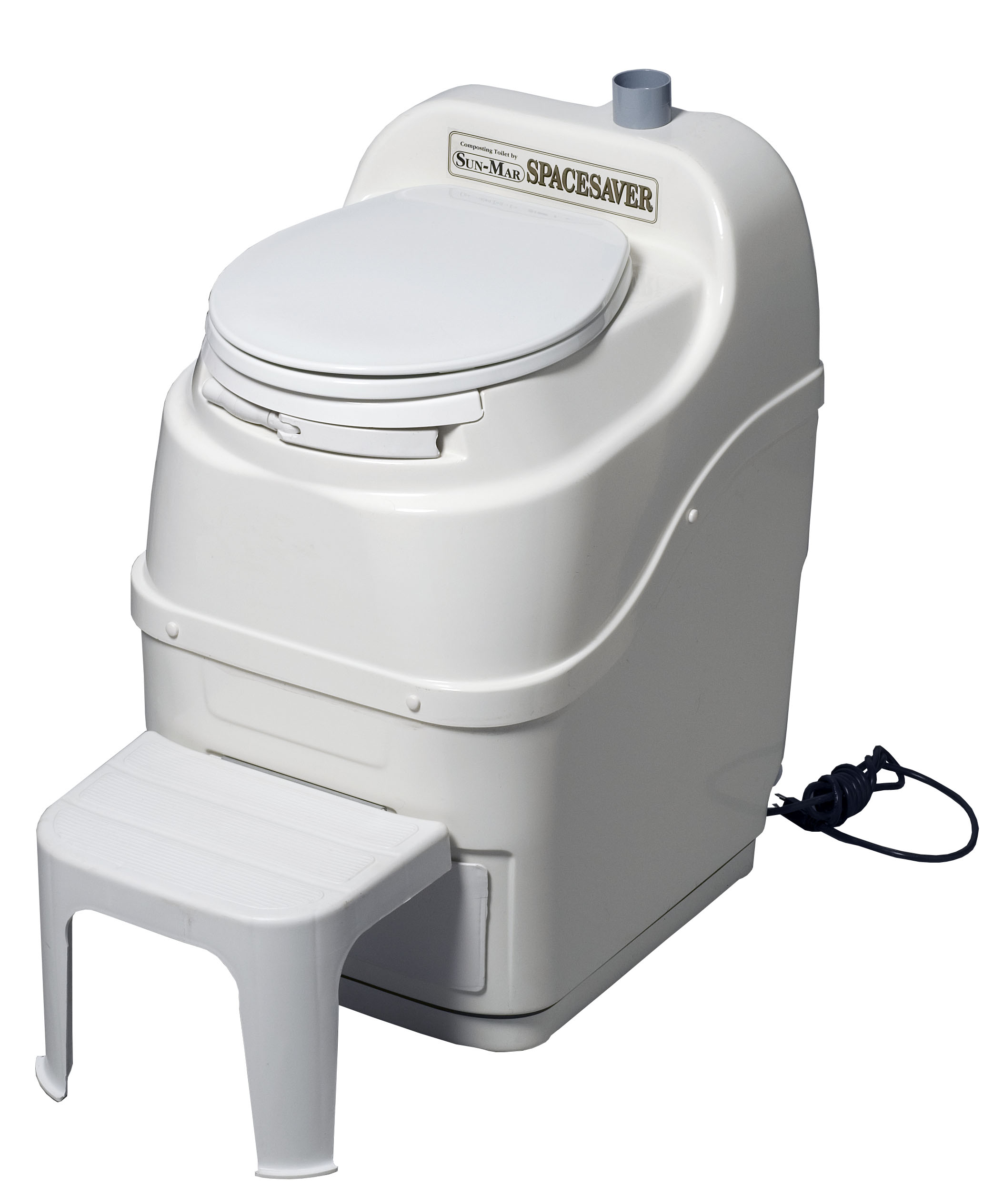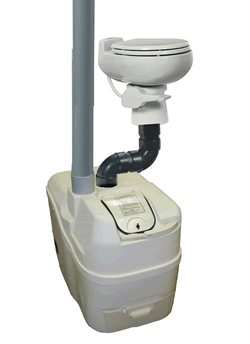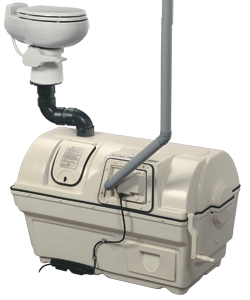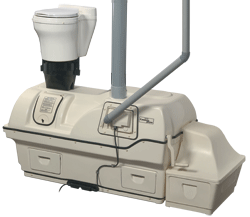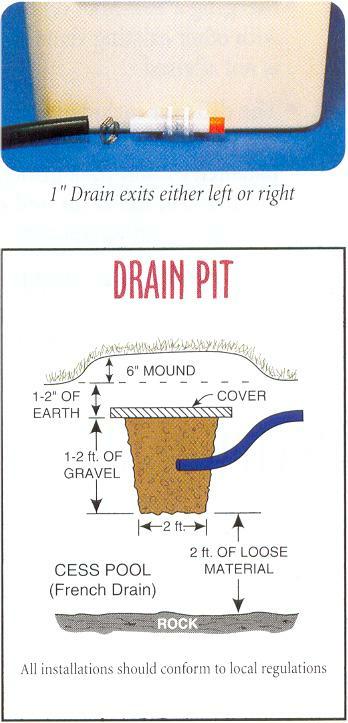Waterless composting toilet install and operation tips
SunMar self-contained waterless composting toilets offer an economical and ecological solution for replacing an incinerating toilet, chemical porta-potty, or outdated outhouse. Waterless composting toilets provide a practical alternative for homes and businesses that suffer from lack of water, difficult topography, low percolation rate, high groundwater, inadequate lot size, or difficult remodel plumbing. Perfect for job sites, guardhouses, golf courses, trailheads, snackbars, pool houses, barns, stables and a great many homes and cabins throughout the world and in every climate. Ideal solution for bathroom facilities where the toilet is not used for months at a time and/or allowed to freeze during the winter months. Compost just goes dormant when frozen or dried out and is easily restarted with a hot water soaking and the return of warmer weather. Check with building department since the 'appliance' may be required to have NSF standard #41 certification.
Composters constantly vent air to refresh the oxygen-driven biological breakdown of toilet waste. While it may not be necessary to have an electric fan assist the ventilation of a healthy composter, it is highly recommended in windy locations where vent pipe down-drafts are a problem. What noticeable composting odor exists within healthy compost needs to be prevented from escaping under the toilet seat by creating a positive draft, aerating the compost before exiting above the roof line. Healthy compost does not have that ammonia smell like an outhouse or portapotty since the urine is either evaporated, collected, or runs off to an overflow drainage pit in the yard.
Should need to replace a composting toilet's internal blower, we suggest purchasing an after-market in-line exhaust fan instead of the factory part. Outfit the inline fan with a variable speed control switch (shown below) so you can correctly dial-in the air flow power. Sun-Mar parts are best purchased direct from the manufacturer.
We recommend this model of in-line fan at Amazon to replace a malfunctioning in-cabinet Sun-Mar composter fan assembly. Or upgrade a non-electric NE (*see below).
We recommend their Vari-Speed control to adjust exhaust flow to meet the needs of your composter's vent pipe configuration.
You may need 4" by 2" rubber couplers to go from smaller vent pipe to the four inch diameter standard exhaust fan openings.
Sun-Mar Excel model self-contained composter
We are not selling Sun-Mar composters at the present time, but they can be found online at HomeDepot and any of the few remaining regional dealers. Two Sun-Mar Excel self-contained composting toilets have been serving our home and warehouse for well over thirty years now. We could have sold other brands of composting toilet, but none have proven to be anywhere near SunMar's equal in terms of capacity, ease of operation, and long-term reliability. Intermittent vacation cabin usage may be possible for those cheap composters you see online, but year-round, full-time residential use by multiple people is a job for Sun-Mar's Excel self-contained composting toilet and their Centrex 'central' composting systems.
Installation involves setting unit directly on the floor, cutting hole in roof for vent pipe, and connecting emergency over flow hose to a small drywell or holding tank. Excel 'AC model' plugs into household outlet to power up the fan and evaporative heating mat. Unlike other brands, Excel has a very convenient tray for removing dry finish compost material. Easiest to maintain model with very few moving parts and almost no metal components. Excel ensures stable composting with larger bio-drum for longer retention time and less frequent maintenance. Properly operated, the Excel bio-drum design always functions properly. At the heart of any problems you may hear about is lack of proper care and feeding.
Sun-Mar Excel AC model shown and SpaceSaver and Compact have an internal blower in the composter body, which speeds dehydrating while circulating air inside the body. All three models also have an evaporative heating mat in the base of the evaporation chamber underneath the finishing drawer. Carbon fiber electric heating mat does not actually heat the compost, it just elevates the temperature of excess liquid in the base so that it evaporates faster. In practice, one always hooks up the emergency overflow hose, so dehydrating all of the excess liquid is not a necessity for self-contained composters. We recommend running overflow hose to our drywell leach pit kit.
Sun-Mar composter kits all include: one large bag of Compost Sure, starter packet of Microbe Mix, scoop, rake, vent pipe, couplers, and a unique draft improving vent cap diffuser. Generally everything needed for the average building installation except roof flashing for the vent pipe exit and overflow pipe and hose clamps for liquid effluent solution. NSF standard #41 certified units were tested for six continuous months at their maximum capacity of four adults, meeting all applicable health codes for installation in residential or light commercial applications. Our shopping cart is currently inactive for Sun-Mar composters, but they can be found online at HomeDepot and any of the few remaining regional dealers.
Sun-Mar Excel AC electric model comes with recirculating 110 volt AC fan built right into its sleek fiberglass chassis. Plus, a low power usage carbon fiber evaporative heating mat (no moving parts to fail) in the base, outfitted with a thermostat to help speed liquid evaporation. Excel is the largest self-contained composter at 22-1/2 inch wide and 33 inch deep and 33-1/4 inch tall, providing plenty of bio-drum room for easiest maintenance. Cabinet recirculating fan is very quiet, but possible to have an optional speed control shut-off switch installed at the factory for about $50.
Sun-Mar Excel AC/DC electric model is an Excel AC model composter PLUS Sun-Mar's AC/DC installation kit to convert unit with a 4 inch direct vent stack for use without standard 110 volt AC electricity. AC/DC installation kit includes a 12 Volt DC 2.4 watt axial fan mounted inside a coupler fitting, hole saw for cutting your own 4-1/4" top vent hole, 12 feet of 4" pipe plus four coupler fittings, and a 6" diffuser vent cap to encourage positive drafting. Should you never intend on running composter on 110 volt AC power, we recommend buying an Excel NE and saving about $200.
Sun-Mar Excel NE non-electric model lacks recirculating exhaust fan and evaporative heating mat found on AC. There is a 4 inch vent pipe rising straight out the top, rear of unit. Larger diameter for better drafting airflow when installed without a fan. For best natural drafting, vent the unit directly up through the roof and insulate the four inch vent pipe after it passes from heated bathroom to help prevent thermal down-drafting (rising warm air cooling and dropping). An optional 12 volt DC 2.4 watt in-line axial fan is available from Sun-Mar for about $50. Or you can build you own more powerful 12VDC in-line exhaust blower yourself using a 4 inch diameter pipe coupler fitting and mounting an 80mm computer axial fan inside.
* The most economical option is to purchase an Sun-Mar Excel NE non-electric model then install an after-market 110 volt AC blower. We do not stock a four inch in-line vent fans but they are readily available at Amazon.com. Best practice is a blower rated for about 150 CFM and then reduce speed as need be with their variable-speed control to maintain positive air flow out the vent stack on roof. Running blower on less than top speed ensures longevity and minimal noise. Fan is placed in-line on the four inch vent stack pipe near the roof, not near the composter, to best encourage drafting. Unlike the two inch vent stack on the Excel AC, when your power goes out a four inch vent pipe should continue drafting adequately to prevent odor from entering the bathroom. Key when your power goes out, is to seal underneath the toilet seat with a garbage bag or rug to encourage drafting up the vent pipe and not out from underneath the toilet seat. For those off-the-grid, you can build your own silent 12VDC in-line fan from an '80mm computer case axial fan' mounted inside a four inch pipe coupler fitting. Sun-Mar's 12VDC fan packaged with Excel NE is only 2.4 watts, which may be too low power for some vent pipes.
Sun-Mar Compact and SpaceSaver model self-contained composters
SunMar Compact is only purchased when you absolutely must not have the front step, as seen on the much larger Excel. Compact has nearly the same footprint at 21-1/2 inch by 33 inch deep so it does not save any floor space, just shorter so it does not require the front footrest. Larger Excel model has nearly double the bio-drum capacity for less frequent maintenance. A single Compact is not suggested for full-time residential use by more than one person. Refer to Sun-Mar website for Compact product details and specification sheets.
Sun-Mar Mobile for use on boats and in RVs is currently unavailable. Mobile unit is a SpaceSaver with baffles installed in the base. No other composters can be installed in a moving vehicle without risking liquid sloshing out the front.
Sun-Mar SpaceSaver is generally not purchased unless the composter must fit into a smaller footprint than 23 inch wide. Toilet base is only 19-1/2 inch wide (22-1/2 inch for Excel) by 23 inch deep (33 inch for Excel) and 30 inch tall, but it is extremely rare to see toilet stalls less than 24 inches wide. Building code dictates a minimum 30 inch toilet clearance. The larger Excel model has nearly double the bio-drum capacity for less frequent maintenance. A single SpaceSaver is not suggested for full-time residential use by more than one person. Refer to Sun-Mar website for SpaceSaver product details and specification sheets.
Sun-Mar Centrex 'central' composting toilet systems
Sun-Mar Centrex series central composting toilet installation and operation are much the same as a self-contained Excel. Highlight being that it is best to install the Centrex composter on top of an insulated waterproof clean-able deck in basement. Bringing the unit up a foot (or so) makes maintenance easier, helps keep compost warmer, and provides better plumbing access for liquid overflow pipe. There are two models of Sealand low-flush toilets sold for Sun-Mar. Sealand 510+ 'Plus' is the standard 17 inch toilet height (as seen above with recommended 180 jog in waste pipe). The Sealand 511+ 'Plus' is much the same with shallower bowl and only 13 inch height which allows it to be mounted on a platform. Platform is only needed when the toilet drain pipe does not drop directly down into the composter. When you have to make an immediate bend and run pipe laterally atop floor/deck, then the shorter 511+ is chosen. Otherwise, the 510+ is standard practice. Especially when using a low-flush toilet, you must have a solid plan for disposing of liquid effluent overflow. We recommend the drywell leach pit system.
Sun-Mar Centrex 1000, 2000, and 3000 series pictured below are all NSF standard #41 certified central composing toilet systems. Components vary with choice of AC, AC/DC, or NE non-electric model and type of toilet: AF air-flush dry fixture or Sealand 510+ or 511+ pint-flush toilet fixture. Refer to SunMar website for Centrex low-flush central composter product details and the Centrex AF dry toilet central composting system details. Our shopping cart is currently inactive for Sun-Mar composters, but they can be found online at HomeDepot and any of the few remaining regional dealers.
installation, maintenance and operational highlights
Attaching the liquid overflow hose directly to an exterior drainfield should be mandatory with any composter, even units equipped with evaporative heating mats. If a drainage pit in the yard is not initially possible, a holding tank outside or in the crawlspace is an option. Use a labeled red gas can to encourage respect and send the overflow hose right down the spout. Empty collected liquid effluent into a flush toilet or RV dumping station. Lacking proper disposal facilities, dig a post hole at least two feet deep for disposal and cover with topsoil. Wear adequate breathing, skin, face and eye protection when handling human waste. We recommend using the drywell leach pit kit for disposing of liquid effluent.
Always leave at least one pipe joint in the vent at rear/top of composter unglued to allow moving the toilet later, without having to cut the pipe. Examples are shown below, but note that a straight vertical vent pipe is always produces the best draft. If you are forced to make bends, use 22.5 or 45 degree bends, never an abrupt 90 degree bend. Best practice is to keep pipe inside the building, especially in cold climates where chilling the exhaust and vent at least 20 inches above roof peak to avoid downdrafts. Sun-Mar includes a draft inducing terminus with every kit to help create a low pressure zone atop pipe and prevent rain from entering. Insulate all exterior and uninsulated attic vent pipe to ensure proper drafting, especially in cooler climates.
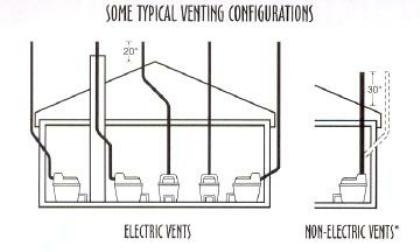
SunMar kits include all the pipe and fittings you will need for the average installation except one inch inside dimension overflow hose and vent pipe roof flashing. Four inch diameter vent is commonly available SDR35 sewer-drain pipe should you need extra. Their two inch outside diameter vent pipe is unique to in-house vacuum systems, but you can use two inch Sch40 with a rubber boot coupler.
Always insulate the floor underneath self-contained composters - retaining heat inside the unit will help maintain efficiency of the natural composting action. If you install on a concrete floor, you must at least place a layer of foam insulation, or better yet, an insulated three foot by six foot platform built of 2by4 wood to act as a solid thermal break. Be sure to install the unit on a flat surface or slightly tilted towards the rear, never sloping to the front. When it is not possible to install in a heated bathroom, one should at least insulate the room and hopefully provide some direct sunlight warmth. Skylights are a nice addition to any composting toilet room design. SunMar composters are a good choice for locations where the toilet is not used for months at a time and/or allowed to freeze during the winter months. Compost will just go dormant when frozen or dried out and is easily 'restarted' with a good soaking of warm water.
Start the composting toilet 'bed' with 2 parts peat moss mixture and 1 part rich topsoil - moisten well and in the beginning, keep towards the front 2/3 of tumbler bin bottom away from the screen in back. Until the starter bed mixture develops into mature compost, fragments of soil and peat may slip through screen in back, especially when not kept moist. In any case, a few solids will accumulate and they are not necessary to remove immediately, but you can with enclosed rake. Topsoil mixture needs to be insect egg free, so seal it in a black plastic garbage bag, moisten well, and leave in direct sunlight for a couple of days to bake. Turn and shake the bag once or twice a day to ensure direct and even heating of the soil.
Good healthy, active compost takes a few weeks to get properly started - be patient and give it time to mature. Composting action stops if the pile is allowed to dry out completely, so monitor and tumble to moisten thoroughly, adding warm water when need be. If the compost is way too moist, it will eventually turn into pudding because not enough bulking material is being added and oxygen cannot penetrate the pile. Before compost ever reaches that point though, you will notice an offensive septic ammonia odor. If this happens, add at least one gallon of pine planer shavings and tumble well to help dry it out and allow air back into pile. Compost accelerant should be periodically added to ensure optimal composting. Baker's yeast works fine, as does adding a couple slices of crumbled-up dry, not moldy, bread like stuffing cubes every week.
Add a quarter to half cup of bulking material per bowel movement - best practice is to toss your toilet paper to rear or front of tumbler so excrement can be covered with a handful of pine planer shavings. Key to good compost is adding bulking material regularly, so the fecal matter layers-in with plenty of air pockets that breathe trapped air inside the pile. Place a small waste basket full of bulking material atop the unit to ensure it is regularly added. There is no need to tumble the drum after every bowel movement. Excessive tumbling may hinder the composting action by compacting the material and driving out air.
Tumble the compost thoroughly every other day or at least twice a week - rotate the bio-drum three full, complete rotations, noting that it takes six revolutions of the handle to make one full drum rotation. There is no need to tumble the drum after every bowel movement. Excessive tumbling will actually hinder the composting action by compacting the material and driving out air. Routine tumbling ensures loose, moist, and evenly distributed compost. Failure to regularly tumble can lead to clumping and poor overall compost health due to dry, packed air-less conditions. Clumps in the compost allows urine to pass through much too quickly, resulting in excess liquid effluent in the base. Whenever you remove the finish material tray, always use the provided rake to pull any debris underneath to the front, so it cannot clog your outlet overflow holes. We have found that putting ~3/8 inch thick board underneath the front of composter helps encourage liquid in base to flow out the back and leave the space in front dry for debris you pulled up. Be certain to cover the bottom edge completely from side to side and leave at least an inch hanging out the front to protect cabinet.
Should you encounter completely over-saturated compost - the screen in lower rear of compost drum is likely clogged, preventing excess drainage into base. Rotate the composter drum handle three turns, so the bio-drum is upside down. Wear gloves and remove the toilet bowl liner and shine a flashlight into the top rear - you will see the stainless steel screen. This screen allows excess liquid to drain from compost down into the base of unit. When composter is not tumbled on a regular basis, the screen can cake with dried compost and get clogged. After covering your arm with plastic wrap, and while wearing gloves, you can reach into the unit and free the dried material on the screen. A large nail or hair brush with well-spaced stiff bristles can be forced down through the screen to free the openings and allow compost to drain normally.
Let the partially composted material in the finishing drawer sit undisturbed - for a couple of weeks and be totally dehydrated before removal and then immediately back-tumble a new load into the finishing drawer. Keep the bio-drum about 1/2 full for maximum moisture (and heat) retention and most carefree operation. When the flap in top of drum catches on compost after being tumbled, it is way, way too full. Always tumble the composter very well, four or five complete revolutions of the bin (not just the handle), before back-tumbling the next load into finishing drawer. You want to see fresh material thoroughly mixed with compost before depositing into drawer for final dehydrating. Check with local health codes, but finished compost can be added to an exterior compost pile for later tilling into ornamental plantings, or buried a foot underground near a tree or bush, or simply thrown in the landfill. Take proper health precautions when handling finished compost: the same rules apply as to septic tanks - avoid direct skin, mouth and eye contact. Whenever you remove the finish material tray, always use the provided rake to pull any debris underneath to the front, so it cannot clog your outlet overflow holes.
Healthy composting toilet material inside the drum is not an environment favorable to insect life - active, healthy, moist compost, being tumbled regularly is generally too hot and disturbed for insects to thrive. Discourage insects from taking up residence in the first place, by spraying with a mild insecticide atop the air intake screen on side of composter, under the removable toilet bowl, under seat and lid, and around the base at floor. Then lightly spray the edges of a heavy rug and throw it over the top, entirely covering the area around toilet seat. Rugs and quilts are very effective sealing tools, as are automatic closing screen doors on bathrooms. If you use insecticide inside the composter cabinet (atop the compost), keep that fact in mind when using finish compost in your garden around edible plants. Compost removed from Sun-Mar should be composted a second time in your yard waste composting bin, never applied directly after being removed.
Should your toilet experience a fly infestation - kill them and then spray everything one more time for good measure. While prudent to avoid spraying the compost itself with harsh insecticides, there must at least be enough clinging to the outside of the barrel and inside of composter body to discourage return. Note that insects are not breeding and laying eggs in healthy compost; they are generally active outside the drum, somewhere inside the cabinet. Normally, one does not clean anything inside the composter cabinet, only periodically removing fully dehydrated compost from finishing drawer. Should you have an insect infestation that simply will not go away, it may need to be cleaned, though. This is a good time to remind everyone that toilet waste is hazardous septic human waste and must be approached with proper safety equipment and plenty of caution. Wear disposable protective clothes with full head/mouth covering, face shield and/or goggles, and protected sleeves and gloves. In a pinch, Saran wrap can be put around arms and then securely taped to the gloves. Start by removing the toilet bowl and cleaning any material clinging to side of drum or inside of cabinet. Spray all interior surfaces, soaking well with natural pyrethrins, or more powerful aerosol sprays, and "bomb" the composter for a day or two. For best results, turn off the fan and wrap/seal all openings with plastic stretch-wrap kitchen cling film. After you stop the infestation, spray the air intake areas, surrounding floor, under bowl, and under toilet seat to discourage future visitors.
The liquid in the bottom of the composter will eventually dehydrate - excess will flow out the back through the overflow hose. Never try to remove liquid effluent in bottom of composter - do not mess with it - the extra humidity is helpful, if nothing else. Should it not be evaporating, and the heating mat is functional, there is likely a skim-coat of oil atop the liquid preventing natural evaporation. Squirt a healthy amount of liquid dish detergent atop the liquid in base to break up the oil coat and evaporation will get back on track. Also check to be sure the air intake vent grate(s) on body of composter are clean. Dust and debris can clog the air intakes, preventing cross draft from evaporating liquid properly. When you remove the finish drawer material, it is a good time to rake out any debris in base of composter. Under normal operating conditions, debris will not accumulate in the base, so try to keep it clear for best evaporation of excess liquid.
Venting directions follow the same basic rules as any powered vent - a straight vertical pipe up through roof is always best practice. When forced to make bends, use two 45 degree fittings versus a single 90 degree bend. Terminate the vent pipe above peak of roof for best drafting. If this requires bending vent with two 45 fittings inside attic, do so rather than have vent pipe exit lower on roof. Of special importance is to insulate the pipe as it leaves heated room (attic and above roof line) the kit comes complete with a section of foam and additional can be purchased at any home building supply store. A nice touch is to cut a section of four inch pipe to cover the foam insulated pipe as it leaves the roof for protection against sun damage.
If vent is properly installed and you still experience compost odor in the restroom - a few Sun-Mar composters are equipped with a 'gate' on the blower assembly. Remove the #2 square drive screws holding the blower on rear of unit and adjust the gate to zero/closed setting and seal with duct tape If the blower does not have a gate, you may notice that the fan blower terminates about 1/2 inch away from where it exits the back. This opening is designed to circulate air inside cabinet for accelerating dehydration and can be duct taped partially closed to enhance venting. A fuzzy toilet seat cover helps maintain tight seal and in a worst case scenario you can install an in-line booster fan anywhere in the vent pipe before it leaves the roof. Properly maintained healthy compost will not have a septic ammonia odor.
Sun-Mar Microbe Mix, Compost Sure, and Compost Quick
SunMar Microbe Mix is a 100% natural product combining a blend of microbes and enzymes designed to start and accelerate composting in all Sun-Mar toilets. We do not sell Microbe Mix since you can make your own with local materials more economically and ecologically. Key to odor-free operation is aerobic (composting) bacteria which thrives in an oxygen rich environment. Anaerobic (ammonia septic smell) bacteria grows in an oxygen deprived environment llike a bucket of urine. Aerobic bacteria found in composting toilets has a more earthy, fresh tilled garden soil aroma. Excrement does not turn into a rose, but it won't be allowed to go 'septic' when you tumble at least twice a week. Compost accelerant can be baker's yeast or simply adding a couple slices of crumbled-up dry, not moldy, bread like stuffing cubes every week.
Sun-Mar Compost Sure bulking material is a mixture of sphagnum peat moss and shredded hemp stalk. We do not sell Compost Sure since you can make your own with local materials more economically and ecologically. Shipping costs are prohibitively expensive for such large bags. Ranch supply and most feed stores sell 3.6 cubic foot compressed bales of pine planer shaving for less than $10. Before compressing into a bale, that amounts to almost 10 cubic foot, which is more than you can use in a year. Shavings, never sawdust, and pine is best, not hardwood, cedar, redwood, or treated wood shavings that would harm the compost. Mix planer shavings 60/40 up to 80/20 with sphagnum peat moss, with many full-time high-usage clients using 100% pine planer shavings. Peat moss can always be added separately in bulk should compost become too dry and you need to retain more moisture. Keeping the compost light and aerated with more shavings reduces the chance of sodden compost having an offensive septic odor. If the compost is 'clumping' then you have not been adding bulking material after every bowel movement or you are using too much peat moss.
Sun-Mar Compost Quick cleaning product and compost accelerator is composed of a natural enzyme solution. We do not sell Compost Quick since composters are much more economically and effectively cleaned with Windex. The cleaning solution is never sprayed inside the bio-drum, directly atop the compost, so there is no need for a "natural enzyme solution" designed to accelerate composting action. Any cleaning solution mild enough to not harm the fiberglass body will work fine. A natural way to speed composting is to add a couple slices of crumbled-up dried, not moldy, bread every week or two.
Drywell leach pit kits are highly recommended for overflow
Drywell leach pit kits are the optimal accessory for disposing of excess liquid overflow from composting toilets. While possible to install a very basic gravel filled drain pit, as seen above, a drywell leach pit kit will provide life-time service without worry about soil saturation and eventual failure. Drywell system cut sheet with gravel installation detail is available for engineers. Geotextile fabric can be purchased from us for for installation above and around the gravel layer. Geofabric keeps backfill soil from clogging the gravel and is crucial to extending the life of your leach pit. Loosen 'scarify or till' soil at least one foot deeper than the base of leach pit. For optimal water percolation, you must avoid compacting 'smearing' soil in the hole's base and sides. While possible to install gravel-less, using the soil you just removed from hole for backfill, it always pays to install at least one or two feet of 3/4 to 1-1/2 inch gravel under and around them. Please go to this website page for installation details, design tips, and drywell shopping cart.
Flood alarm battery powered moisture sensor
High water level alert moisture sensors are an integral part of many sustainable design systems. Sump pumps, cisterns, septic tanks, greasetraps, water storage tubes, and greywater filters alike benefit from an early warning overfill alarm. Washing machines, water heaters, pressure tanks and other household plumbing will eventually leak.
Hear about the leak long before a liquid spill spreads and you smell the problem. Stop major spills long before they get a chance to start. Solidly built with 3 inch wide, 4.25 inch tall, and 1.5 inch deep housing with detachable sensor plate with two contacts on bottom. One 9 volt battery powers the alarm with 110db alarm that can be heard throughout your house. Will keep screeching for up to three days on a fresh battery. Easy to install kit can simply be placed on the floor to detect as little as 1/32nd of an inch of water or mounted on a wall with removable probe contacts on bottom set remotely. Equipped with a 6 foot long sensor wire, you can provide additional 20 gauge wire and extend probe up to 100 feet. Alarm will not be very loud at such extreme distance from sensor plate, but it is possible. Five year manufacturer's warranty against defects may be affected.

